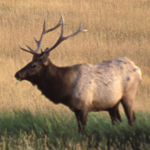|
HOME --> CLASS MAMMALIA
--> ORDER RODENTIA
--> SUBORDER MYOMORPHA
--> SUPERFAMILY Muroidea
--> FAMILY Muridae
--> SUBFAMILY Murinae
--> GENUS Micromys
SPECIES Micromys minutus
| Author: | Pallas, 1771. | | Citation: | Reise Prov. Russ. Reichs., 1: 454. | | Common Name: | Harvest Mouse | | Type Locality: | Russia, Ulyanovsk. Obl. Middle Volga River, Simbirsk (now Ulyanovsk). | | Distribution: | From NW Spain through most of Europe (including Thrace region of Turkey; Kryštufek and Vohralík, 2001, but missing from the Alps, Portugal, and most of Sweden, Norway, Italy, and Spain; Mitchell-Jones et al., 1999), across Siberia to Ussuri region and Korea (Won and Smith, 1999), north to about 65°E in European Russia and Yakutia, south to N edge of Caucasus and N Mongolia (Gromov and Erbajeva, 1995); isolated ranges in NW China (Xinjiang) and throughout S and NE China (from SE Xizang in west to Heilongjiang and Nei Mongol in far northeast; Wang, 2003, and Zhang et al., 1997); south to NW Vietnam (Dang et al., 1994), N Burma (Anthony, 1941; Ellerman, 1961), and NE India (Meghalaya and Nagaland; Agrawal, 2000). Island distributions include Britain; Texel, Terschelling, and Ameland off coast of Netherlands in Wadden Sea (Mostert, 1992b; Naber, 1982); Japan (Honshu, Shikoku, Kyushu, and Tsushima), Quelpart Isl (Korea), and Taiwan (M.-J. Yu, 1996); see Corbet (1978c) for details, and map by Gromov and Erbajeva (1995). Possibly introduced to the Japanese Isls because no fossils have ever been found while all the Japanese endemic muroids are represented by Pleistocene and Holocene fossils (Kowalski and Hasegawa, 1976). The species also occurs in Great Britain where it was also probably introduced (Sutcliffe and Kowalski, 1976; Yalden, 1999). | | Status: | IUCN – Lower Risk (nt). | | Comments: | Reviewed by Corbet (1978c, 1984). Chromosomal information reported by Jüdes (1981), Zima (1983), Lungeanu et al. (1984), Solleder et al. (1984), and Schmid et al. (1987). Results of morphometric analyses of selected European samples and its significance to applying subspecific names to the geographic variation reported by Kratochvíl and Simionescu (1983). Alveolar pattern of molar roots and comparisons with those of Rattus and Apodemus reported by Gallego (1974). Phallic morphology of Chinese samples described by Yang and Fang (1988) in context of assessing relationships among Chinese murines. Haffner (1996) described a tendon-locking mechanism in M. minutus that is engaged when the middle phalanx is bent so that less muscular energy is expended when twigs or stalks are grasped. This structure should be compared with digits in species of the related Vandeleuria and Vernaya. European populations reviewed by Böhme (1978a) and Mitchell-Jones et al. (1999). Indomalayan populations reviewed by Corbet and Hill (1992), who discussed the morphological differences between European and Indomalayan samples. Regional reports covering range, ecology, and other biological aspects available for S Norway (Kooij et al., 2001) and SW Sweden, where it was introduced by humans and is now possibly extinct (Hansson and Fredga, 1996); N Germany (Dolch et al, 1994); Austria (Bauer and Spitzenberger, 1996); Slovakia (Danko, 1994; Kminiak, 1996; Stanko, 1995; Stanko and Mošanský, 1994, 2000; Stanko et al., 2000); Czech Republic (AndŤra and „ervený, 1994; Miloš, 1994; Smaha, 1996; Zima and AndŤra, 1996); Translvanian Romania (Istrate, 1998); Slovenia (Kryštufek, 1991); SE Greece (Thrace; Vohralík and Sofianidou, 1992a); Albania (Prigioni, 1969); Serbia and Montenegro (Kryštufek and Kovacic, 1984; Petrov, 1992); Bulgaria (Peshev, 1996; Vohralík, 1985); N Spain in Navarra region (Castién and Gosálbez, 1992); N Italy (Agnelli and Lazzeretti, 1995, who also documented identity of Mus meridionalis with M. minutus; Amori et al., 1999; Paolucci et al., 1993); Baltic region (Miljutin, 1997, 1998; Timm et al., 1998;); Lithuania (Juškaitis and Baranauskas, 2001); Netherlands (Mostert, 1992b; Thissen and Hollander, 1996); Belgium (Libois, 1996); Great Britain (Perrow and Jowitt, 1995, who also described decline and future of populations); and Japan (Dobson, 1994; Kaneko, 1994). European late Pleistocene and Pleistocene records reviewed by Kowalski (2001). |
|
| Offspring: | Synonyms:
agilis Dehne, 1841
aokii Kuroda, 1922
arundinaceus (Petenyi, 1882)
arvensis (Leach, 1816)
avenarius (Wolf, 1794)
batarovi (Kastschenko, 1910)
berezowskii Argyropulo, 1929
brauneri Martino, 1930
campestris (Desmarest, 1822)
danubialis Simonescu, 1971
erythrotis (Blyth, 1856)
fenniae (Hilzheimer, 1911)
flavus (Kerr, 1792)
hertigi Johnson and Jones, 1955
hondonis Kuroda, 1933
japonicus Thomas, 1906
kastschenkoi Charlamagne, 1915
kurodai Mori, 1942
kytmanovi (Kastschenko, 1910)
mehelyi Bolkay, 1925
meridionalis (Costa, 1844)
messorius Kerr, 1792
minatus (Schinz, 1840)
minimus (White, 1789)
oryzivorus (de Sélys-Longchamps, 1841)
parvulus (Hermann, 1804)
pendulinus (Hermann, 1804)
pianmaensis Peng, 1981
pratensis (Ockskay, 1831)
pumilus (F. Cuvier, 1842)
pygmaeus (Milne-Edwards, 1872)
sareptae (Hilzheimer, 1911)
shenshiensis Li, Wu, and, Shao, 1965
soricinus Hermann, 1780
subobscurus Fritsche, 1934
takasagoensis Tokuda, 1939
takasagoensis Tokuda, 1941
triticeus (Boddaert, 1785)
typicus (Barrett-Hamilton, 1899)
ussuricus (Barrett-Hamilton, 1899)
zhenjiangensis Huang, 1989
|
|
|



